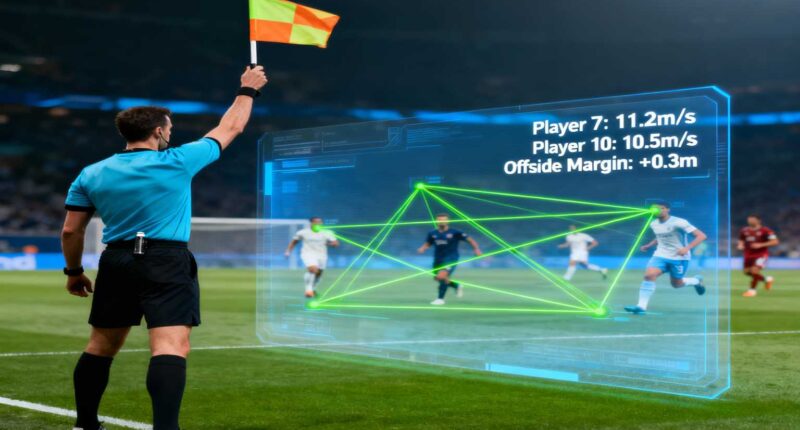Introduction
English football has always been at the forefront of innovation, and the introduction of Semi-Automated Offside Technology (SAOT) represents another milestone in this ongoing evolution. Designed to enhance accuracy, efficiency, and fairness in offside decisions, the SAOT system made its English football debut during the 2025 FA Cup fifth round before being officially implemented in the Premier League from April 12, 2025.
This advanced system merges artificial intelligence, optical tracking, and real-time data processing to support referees in making faster and more reliable decisions. As fans demand more transparency and consistency from VAR decisions, SAOT offers a cutting-edge solution that transforms how the offside rule is enforced.
What Is SAOT?
Semi-Automated Offside Technology (SAOT) is a support mechanism for the Video Assistant Referee (VAR) system. It automates key components of the offside decision-making process by using multiple tracking cameras to identify player positions and relay precise data to officials in real time.
Unlike traditional VAR, where human operators manually set offside lines and determine the exact moment of a pass, SAOT automatically generates those points. While VAR still reviews and confirms the result, automation eliminates much of the subjectivity and potential human error that previously slowed decisions.
The system does not replace referees but acts as an intelligent assistant—providing technology-driven evidence that ensures the right calls are made quickly.
The Technology Behind SAOT
Optical Player Tracking and Mesh Data
The foundation of SAOT lies in optical tracking technology. Each Premier League stadium now houses up to 30 high-speed cameras, positioned strategically under the roof to monitor every player and the ball from multiple angles.
These cameras track over 10,000 data points per player, including fine details such as the position of the toes, knees, and upper arm—all relevant to determining offside positions. All data is captured at 100 frames per second, double the frame rate of standard broadcast cameras, ensuring precision in every frame of play.
This tracking data forms a 3D “mesh” model of each player’s movement, which gives the system a dynamic understanding of their spatial position on the pitch.
Real-Time Artificial Intelligence Processing
The vast data collected by SAOT cameras is processed instantly by AI-powered algorithms. Whenever the system detects an attacking player potentially beyond the last defender at the moment of a pass, it sends an immediate alert to the VAR room.
The VAR then verifies the offside position and checks critical details such as the ball’s kick point, the accuracy of body mapping, and whether the player was actively involved in play. Once confirmed, the referee receives the final decision either through headset communication or via the pitchside monitor.
This semi-automated process reduces the average offside review time by around 30 seconds, improving the flow of the game for players and supporters alike.
Dragon System in Premier League Grounds
Interestingly, the Premier League has adopted a FIFA-validated iPhone-based system, known internally as “Dragon”, which uses iPhone 14 or newer models as part of its infrastructure. These devices are mounted under stadium roofs to capture synchronized tracking footage.
This innovative choice helps reduce operational costs while maintaining top-tier image capture quality. Combined with cooperation between the Professional Game Match Officials Limited (PGMOL) and Genius Sports, the system operates within a robust data network designed specifically for elite football.
Why the SAOT System Matters
Reducing Human Error
Offside decisions remain some of the most contentious moments in football. Prior to SAOT, VAR officials manually determined offside lines, often leading to debates about human bias or calibration inaccuracies. By transferring much of this responsibility to automated software, SAOT mitigates human error and ensures consistent decision-making.
Improving Game Flow and Fan Experience
Critics often argued that lengthy VAR reviews disrupted the excitement of the match. SAOT aims to solve that issue by cutting decision time by nearly a third. Fans in the stadium and watching at home can now see visualizations of offside calls almost instantly after validation.
These computer-generated 3D graphics clearly illustrate the offside decision, providing transparency that enhances understanding and acceptance among spectators.
Enhancing Referee Confidence
With automation handling the data-heavy technical analysis, referees can focus more on interpreting the game’s subjective aspects. For instance, SAOT cannot determine whether a player is interfering with play; those nuanced judgments remain human. However, by removing technical uncertainties, officials can make quicker and more confident final calls.
Implementation in English Football
After successful use in international competitions such as the 2022 FIFA World Cup, UEFA Champions League, and Serie A, English football became the latest adopter in 2025.
The FA Cup fifth round served as the first live test for SAOT in England, followed by its Premier League debut on April 12, 2025, coinciding with Matchweek 32.
Every Premier League stadium has been retrofitted with SAOT infrastructure, ensuring all top-flight matches benefit from the same level of precision. The deployment was part of a larger transformation to modernize refereeing standards in line with IFAB law updates for the 2025/26 season.
Challenges and Limitations
While SAOT represents a major step forward, it is not flawless. Because it remains semi-automated, there is still a reliance on human interpretation. Cases involving subjective offside—such as whether an attacker obstructed a goalkeeper’s line of sight or attempted to play the ball—must still be reviewed manually.
Additionally, as with any sophisticated AI system, its accuracy depends on data integrity and calibration. Any misalignment or obstruction in camera angles could cause minor discrepancies, though Premier League data so far reports 100% correctness in offside outcomes.
The Future of Football Technology
SAOT is only one part of football’s growing integration with AI and machine learning. Analysts believe that its successful rollout could pave the way for fully automated officiating systems capable of handling all objective elements of the game—from offside to goal-line incidents—without human input.
In the long term, the data generated by SAOT may also fuel sports analytics, player performance tracking, and broadcast innovations. It represents a shift toward data-driven football, where precision and fairness go hand in hand with immersive fan experiences.
Conclusion
The introduction of Semi-Automated Offside Technology marks a transformative moment in English football. By combining AI, optical tracking, and real-time decision support, the SAOT system ensures faster, more transparent, and more accurate offside rulings.
More than just a technological advancement, it symbolizes football’s commitment to integrity and progress—striving to balance the passion of the game with the precision of modern science. As the system evolves, the line between human intuition and artificial intelligence will continue to blur, but what remains constant is the goal: to make football fairer, clearer, and more enjoyable for everyone.









